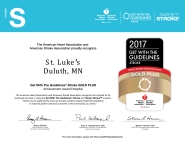Aspirus St. Luke's Receives Get With The Guidelines -Stroke Gold Plus Quality Achievement Award with Target: Stroke Honor Roll Elite
 St. Luke’s has earned the American Heart Association/American Stroke Association’s Get With The Guidelines® -Stroke Gold Plus Quality Achievement Award and has also been named to the list of Target: Stroke Honor Roll Elite.
St. Luke’s has earned the American Heart Association/American Stroke Association’s Get With The Guidelines® -Stroke Gold Plus Quality Achievement Award and has also been named to the list of Target: Stroke Honor Roll Elite.
The award recognizes the hospital’s commitment to providing the most appropriate stroke treatment according to nationally recognized, research-based guidelines based on the latest scientific evidence.
“A stroke patient loses 1.9 million neurons each minute stroke treatment is delayed. This award further demonstrates our commitment to delivering advanced stroke treatments to patients quickly and safely,” said St. Luke’s Cardiovascular Services Coordinator Stan Sadenwasser. “St. Luke’s continues to strive for excellence in the acute treatment of stroke patients. The recognition from the American Heart Association/American Stroke Association’s Get With The Guidelines-Stroke further reinforces our team’s hard work.”
Hospitals must achieve 85 percent or higher adherence to all Get With The Guidelines-Stroke achievement indicators for two or more consecutive 12-month periods. They must also achieve 75 percent or higher compliance with five of eight Get With The Guidelines-Stroke Quality measures to receive the Gold Plus Quality Achievement Award.
To qualify for the Target: Stroke Honor Roll Elite, hospitals must meet quality measures developed to reduce the time between the patient’s arrival at the hospital and treatment with the clot-buster tissue plasminogen activator, or tPA. It’s the only drug approved by the U.S. Food and Drug Administration to treat ischemic stroke. If given intravenously in the first three hours after the start of stroke symptoms, tPA has been shown to significantly reduce the effects of stroke and lessen the chance of permanent disability. St. Luke’s earned the award by meeting specific quality achievement measures for the diagnosis and treatment of stroke patients at a set level for a designated period.
These quality measures are designed to help hospital teams follow the most up-to-date, evidence-based guidelines with the goal of speeding recovery and reducing death and disability for stroke patients.
St. Luke’s has also met specific scientific guidelines as a Primary Stroke Center featuring a comprehensive system for rapid diagnosis and treatment of stroke patients admitted to the emergency department.
St. Luke’s is also the only hospital in the region to offer a new clot removal tool to stroke patients called an endovascular thrombectomy. It’s a tool that’s used by inserting a catheter into the patient’s leg, and then threading a specialized catheter up to the brain to remove the clot which can instantly restore blood flow to the brain.
“The American Heart Association and American Stroke Association recognize St. Luke’s for its commitment to stroke care,” said Paul Heidenreich, M.D., M.S., national chairman of the Get With The Guidelines Steering Committee and Professor of Medicine at Stanford University. “Research has shown there are benefits to patients who are treated at hospitals that have adopted the Get With The Guidelines program.”
Get With The Guidelines®-Stroke puts the expertise of the American Heart Association and American Stroke Association to work for hospitals nationwide, helping hospital care teams ensure the care provided to patients is aligned with the latest research-based guidelines. Developed with the goal to save lives and improve recovery time, Get With The Guidelines®-S has impacted more than 3 million patients since 2003.
According to the American Heart Association/American Stroke Association, stroke is the No. 5 cause of death and a leading cause of adult disability in the United States. On average, someone in the U.S. suffers a stroke every 40 seconds, someone dies of a stroke every four minutes, and nearly 800,000 people suffer a new or recurrent stroke each year.
